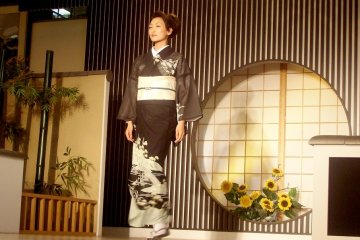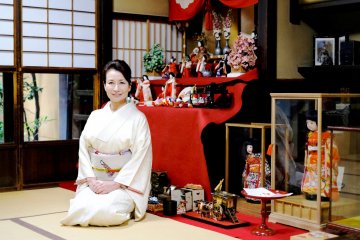Among the numerous temples and shrines in Kyoto, each with their own histories, there is one very unusual shrine, Seimei Jinja, dedicated to Abe no Seimei. Legends, almost fairy tale-like, tell about this man but the existence of the shrine, built in 1007 by order of Emperor Ichijo, is proof that Abe no Seimei wasn't fictional but a real hero who deserves to become a legend.
Abe no Seimei lived in the 10th-11th centuries; thought to have been born on February 21 921 and died on October 31 1005, Seimei lived a long for the period, clearly staying in good health. Perhaps it was because he was an onmyoji, or a fortune-teller practicing onmyodo divination.

The occult creed of onmyodo (based on the doctrine of yin & yang and the five elements) came to Japan from China, around the beginning of the 6th century. The creed was a system of creating predictions, horoscopes, exorcising evil spirits, protecting against curses, and so on. Belief in demon possession and superstition was the norm in those days. In Japan, onmyodo became especially popular by the 10th century, when a state bureau of onmyodo called 'Onmyo-ryo' was created at the court of the Emperor.
Many onmyoji received positions in this institution and Abe no Seimei was considered to be an outstanding onmyoji. His bright personality and incredible talent gave rise to the legend that his father was a man named Abe no Yasuna, and his mother was a kitsune (fox) named Kuzunoha. Legends also say that at the age of five, Seimei could see demons and cope with them, so his mother gave him to the master, Kamo no Tadayuki, to study the art of onmyodo. One day, while traveling with his master, Seimei sensed the approach of demons and woke him up. This saved them, and after that master Kamo no Tadayuki decided to pass all his knowledge to Seimei.
Thanks to his talent and power, Seimei received a high position at the court of the Emperor. He compiled calendars, predictions, consulted on the issue of spiritually correct solutions to problems, performed prayers, exorcised demons, wrote books and so on. According to legends, Seimei had twelve helper spirits called shikigami, which meant he had extraordinary power in exorcising demons and healing people.
However, in the 19th century, the onmyodo doctrine was banned in Japan. Since 2006, though, the study of onmyodo-related rituals was re-allowed. The name Abe no Seimei was forgotten for many centuries, before suddenly becoming extremely popular in 1994, after the publication of the novels of Yumemakura Baku, a 30-volume manga, films, anime and the free program 'Seimei' by two-time Olympic champion Yuzuru Hanyu.

The Seimei Jinja in Kyoto was built on the site of the house where Abe no Seimei had lived. The shrine's symbol is a pentagram in the form of a five-pointed star; Seimei used it as a talisman against all kinds of evil. According to Chinese philosophy, the five ends of a star mean the five elements: water, fire, earth, metal and wood. They also mean five mythological animals: eastern dragon - western tiger - southern phoenix - northern turtle - golden dragon.
On the shrine grounds is a Seimei-ii well and a Modori-bashi bridge that connects the human and spirit worlds, as well as the legendary onmyoji Seimei himself – a spiritual man who lived between two these worlds.
Every year, on the day of the autumnal equinox, Seimei Jinja holds a holiday — Seimei matsuri.
Seimei Jinja is open every day from 9:00 to 18:00









